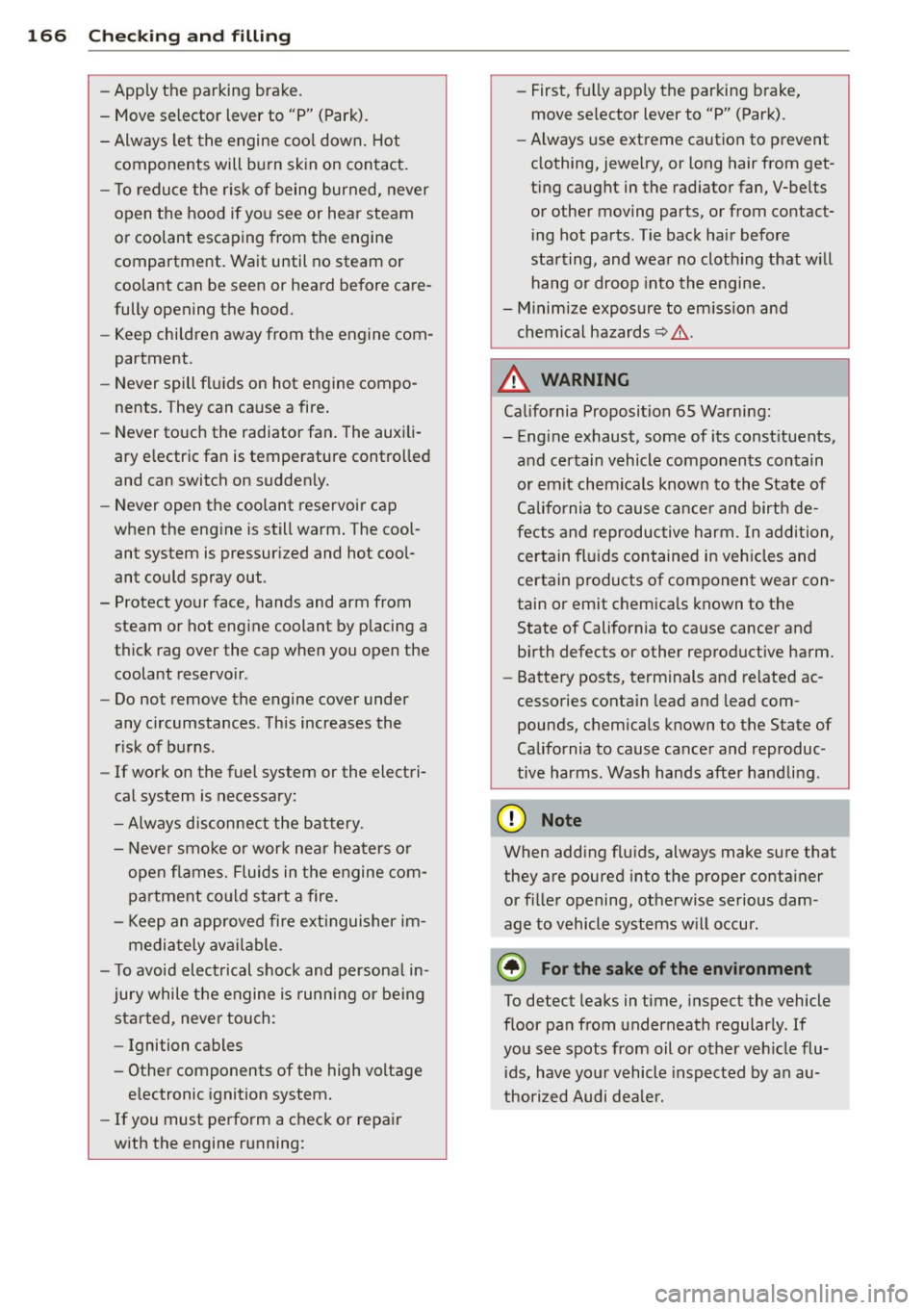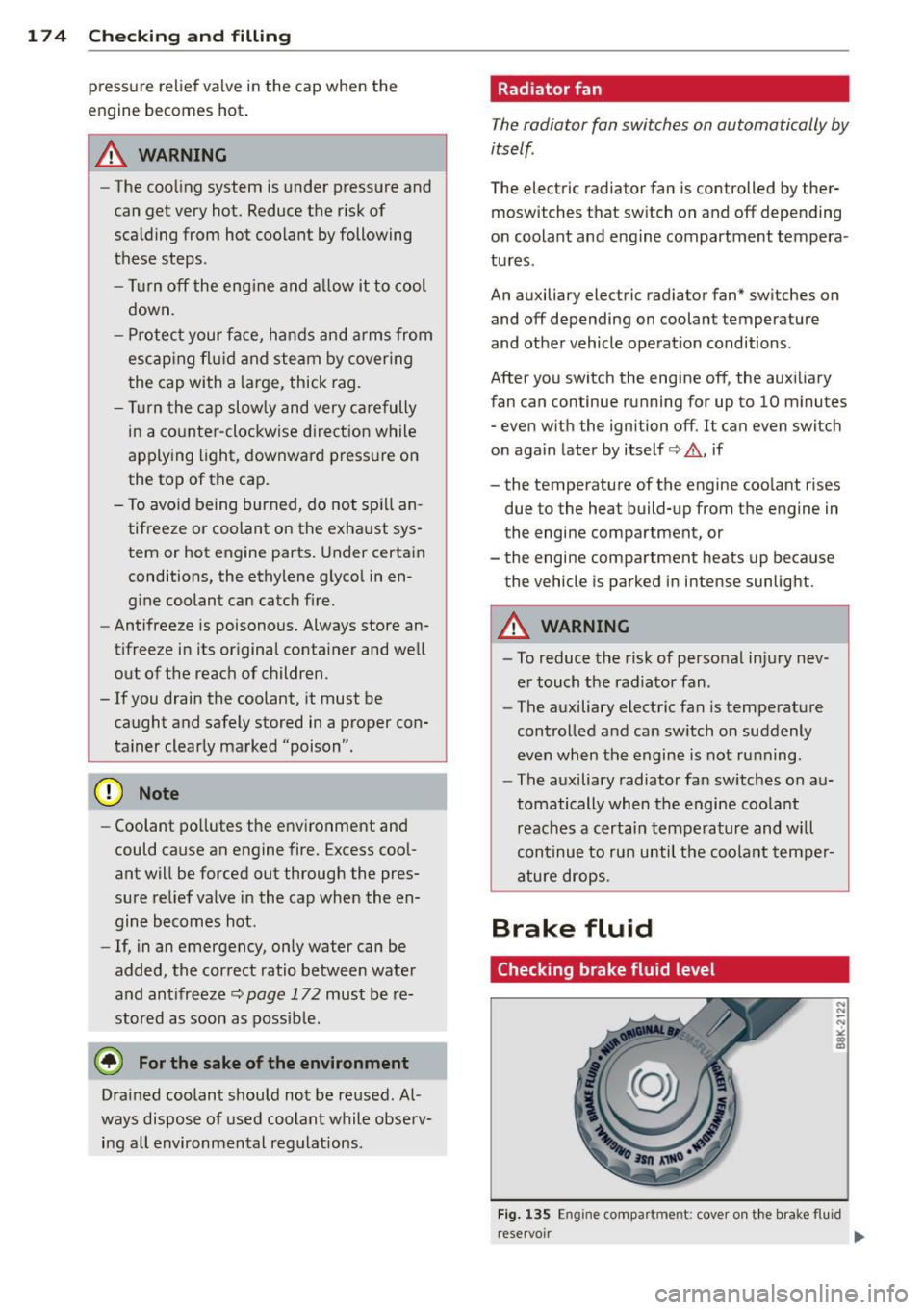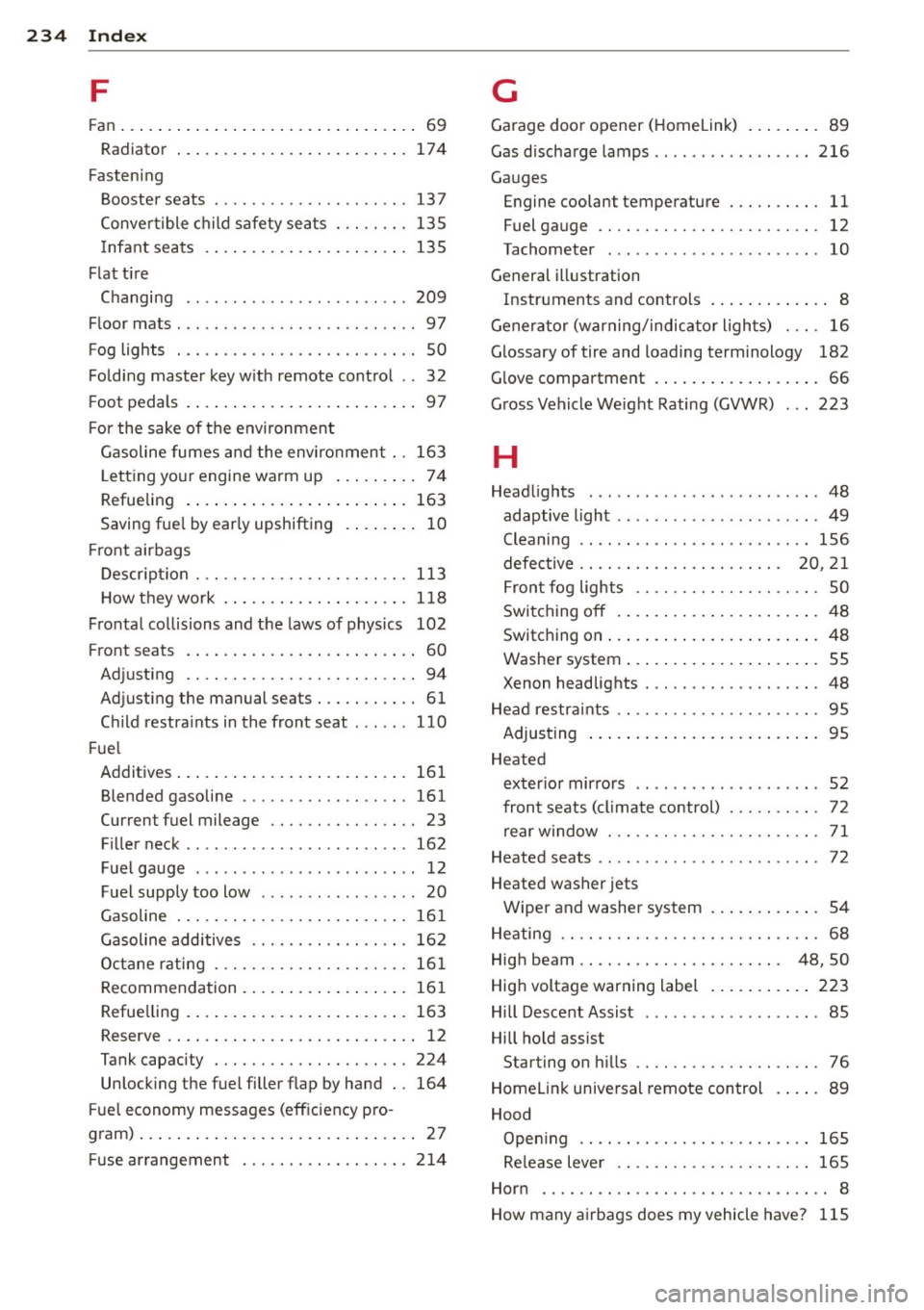radiator cap AUDI TT ROADSTER 2014 Owners Manual
[x] Cancel search | Manufacturer: AUDI, Model Year: 2014, Model line: TT ROADSTER, Model: AUDI TT ROADSTER 2014Pages: 244, PDF Size: 60.87 MB
Page 168 of 244

166 Checking and filling
-Apply the parking brake.
- Move selector lever to "P" (Park).
- Always let the engine cool down. Hot
components will burn skin on contact.
- To reduce the risk of being burned, never
open the hood if you see or hear steam
or coolant escaping from the engine
compartment . Wait until no steam or
coolant can be seen or heard before care
fully opening the hood.
- Keep children away from the engine com
partment .
- Never spill fluids on hot engine compo
nents. They can cause a fire.
- Never touch the radiator fan. The auxili
ary electric fan is temperature controlled
and can switch on suddenly.
- Never open the coolant reservoir cap
when the engine is still warm. The cool
ant system is pressurized and hot cool
ant could spray out .
- Protect your face, hands and arm from
steam or hot engine coolant by placing a
thick rag over the cap when you open the coolant reservoir .
- Do not remove the engine cover under
any circumstances . This increases the
risk of burns.
- If work on the fuel system or the electri
cal system is necessary:
- Always disconnect the battery .
- Never smoke or work near heaters or
open flames. Fluids in the engine com
partment could start a fire.
- Keep an approved fire extinguisher im
mediately available.
- To avoid electrical shock and personal in
jury while the engine is running or being
started, never touch:
- Ignition cables
- Other components of the high voltage
electronic ignition system.
- If you must perform a check or repair
with the engine running: -
First, fully apply the parking brake,
move selector lever to "P" (Park) .
- Always use extreme caution to prevent
clothing, jewelry, or long hair from get
ting caught in the radiator fan, V-belts
or other moving parts, or from contact ing hot parts. Tie back hair before
starting, and wear no clothing that will hang or droop into the engine.
- Minimize exposure to emission and chemical hazards~&, .
A WARNING
=
California Proposition 65 Warning:
- Engine exhaust, some of its constituents, and certain vehicle components contain
or emit chemicals known to the State of
California to cause cancer and birth de
fects and reproductive harm. In addition,
certain fluids contained in vehicles and
certain products of component wear con
tain or emit chemicals known to the
State of California to cause cancer and
birth defects or other reproductive harm.
- Battery posts, terminals and related ac
cessories contain lead and lead com
pounds, chemicals known to the State of
California to cause cancer and reproduc
tive harms. Wash hands after handling.
(D Note
When adding fluids, always make sure that
they are poured into the proper container
or filler opening, otherwise serious dam
age to vehicle systems will occur.
@) For the sake of the environment
To detect leaks in time, inspect the vehicle
floor pan from underneath regularly. If
you see spots from oil or other vehicle flu ids, have your vehicle inspected by an au
thorized Audi dealer.
Page 175 of 244

Checking the engine coolant level
The engine coolant level can be checked with
a quick glance .
Fig. 134 Eng ine compartme nt: cover o n the coolant
expansion tank
Before you check anything in the engine com
partment,
a lway s read and he ed all WARN
INGS ¢ A in Working in the engine compart
ment on page 165.
.,. Park your vehicle on a level surface.
.,. Switch the ignition
off .
.,. Read the coola nt level at the coolant expan
s ion tank
¢ page 167, fig . 130. With a cold
engine, it must be above the "min" mark.
With a hot engine, it can be a l ittle above
the indica ted range.
The location of the coolant expans ion tank
can be seen in the engine compar tment illus
tration
¢page 167.
To obtain an accurate read ing, the eng ine
must be switched
off.
The expans ion tank in your vehicle is equipped
with a n electric coolant level sensor.
When the coo lant level is too low, the warning
light in the Auto-Check System¢
page 17 will
illum inate until you add coolant and the level
has been restored to normal. Even though
there is an electric coolant level sensor, we
still recommend you check the coolant leve l
from time to time.
Coolant loss
Coolant loss may indicate a leak in the cool ing
system. In the event of coolant loss, the cool
i ng system should be inspected immediately
Checkin g and fillin g 173
by your authorized Audi dea ler . It is not
enough merely to add coo lant .
In a
s ealed system, losses can o ccu r on ly if
the boiling point o f the coo lant is exceeded as
a res ult of overheating.
(D Note
Do not ad d any type of radiator leak sea l
ant to your veh icle's engine coo lant. Add
ing radiator repa ir flui d may adverse ly af
fect the function and performance of yo ur
cooling system and could result in damage
not covered by your New Vehicle Limited
War ranty.
Adding coolant
Be very careful when adding engine coolant.
Before you check anyth ing in the engine com
partment,
alway s read and heed alt WARN
INGS ¢ A in Working in the engine compart
ment on page 165.
... Tu rn off the engine .
.,. Let the engine cool down.
.,. Place a thick rag ove r the coolant expansion
tank ¢
page 173, fig. 134 and carefully
twist the cap counter-clockwise ¢_& .
.,. Add coo lant m ixed in the correct rat io
¢ page 172, Coolant .
.,. Twist the cap on aga in tightly.
Rep lacement engine coo lant must conform to
exact specificat ions¢
page 172, Coolant.
We recommend using only coolant add itive
Gl2 ++, Gl3 or in an emergency Gl2+. Do not
use a different additive. In an emergency use
plain water until you can get the correct addi
tive and can resto re the correct ratio . Th is
shou ld be done as soon as possib le.
If you have lost a cons iderab le amount of
coolant, then you should add cold ant ifreeze
and co ld wate r on ly when the engine is cold.
Always use
new engine coolant when refilling.
Do not fill coolant above the "MAX" mark. Ex-
cess coolant will be fo rced o ut through the ..,_
•
•
Page 176 of 244

17 4 Che cking and filling
pressure relie f valve in the cap when the
engine becomes hot .
.&_ WARNING
-The coo ling system is under pressure and
can get
very hot. Reduce the risk of
sca lding from hot coolant by following
these steps .
- Turn off the eng ine and a llow it to cool
down.
- Protec t your face, hands and arms from
escap ing fl uid and steam by cover ing
the cap with a large, thick rag.
- Tu rn the cap slowly and
very ca refully
in a counter -clockwise direct ion while
applying light, downward p ress ure on
the top of the cap.
- To avo id being burned, do not sp ill an
tifreeze or coolant on the exhaust sys
tem or hot engine parts. Under certain
conditions, the ethylene glyco l in en
g ine coolant can catch fire.
- Antifreeze is poisonous. Always store an
t ifreeze in its or iginal container and we ll
out of the reach of children.
- If you drain the coolant, it must be
caught and safely stored in a proper con
ta iner clearly marked "poison".
(D Note
- Coolant po llutes the environment and
could cause an engine fire. Excess cool
ant will be forced out through the pres
sure re lief
valve in the cap when the en
gine becomes hot .
- If, in an emergency, only water can be
added, the correct ratio between wate r
and antifreeze~
page 172 must be re
stored as soon as possib le.
@) For the sake of the environment
Dra ined coolant should not be reused. Al
ways dispose of used coolant while obse rv
ing all environmental regulations .
Radiator fan
The radiator fan switches on automatically by
itself .
The electric radiator fan is controlled by ther
moswitches that switch on and off depending
on coolant and eng ine compartment tempera
tures.
An a uxiliary electric radiator fan* sw itches on
and off depending on coolant temperature
and other vehicle operat ion conditions .
After you switch the engine off, the aux iliary
fan can continue running for up to 10 minutes
-even w ith the ignition off. It can even switc h
on aga in later by itself
c> &. , if
- the temperature of the engine coo lant rises
due to the heat build-up from the engine in
the engine compartment, or
- the engine compartment heats up because
the vehicle is parked in intense sunlight.
.&_ WARNING
-
- To reduce the risk of personal inju ry nev-
er touch the radiator fan.
- The auxiliary electric fan is temperature
controlled and can sw itch on suddenly
even when the engine is not ru nning.
- The auxiliary radiator fan sw itches on au
tomatically when the engine coo lant
reac hes a certain t emperature and w ill
continue to run until the coolant temper
a ture drop s.
Brake fluid
' Checking brake fluid level
N
N
N
" ~
Fi g. 13S Engine compartment: cover on th e brake fluid
reservoir
Page 236 of 244

234 Index
F
Fan ... . ... ... .. .. ..... ... .. .. .... .. 69
Radiator ... .. . .. ..... ... .. .. .... . 174
Fasten ing
B ooste r seats ............ .... .. .. .
137
Conve rtible c hild safety se ats . .. .. .. . 135
Infant sea ts
F lat t i re 13 5
Changing .. ... ......... ... .. .. ... 209
Floor mats . . . . . . . . . . . . . . . . . . . . . . . . . . 97
Fog lights . . . . . . . . . . . . . . . . . . . . . . . . . . 5 0
Fo ld ing master key w ith remote contro l .. 32
Foot pedals . . . . . . . . . . . . . . . . . . . . . . . . . 97
For the sake of the environmen t
G asoline fumes and the environmen t ..
163
Le tting you r engine warm up ... .. .. . . 74
Refue ling . . . . . . . . . . . . . . . . . . . . . . . . 163
Saving fue l by early upshifting . ..... . . 10
Fr ont airbags
D escr ipt ion . . . . . . . . . . . . . . . . . . . . . . .
113
H owtheywork ...... .......... .... 118
Fronta l collisions and the laws of physics 102
F ront seats . . . . . . . . . . . . . . . . . . . . . . . . . 60
Ad justing ....................... ..
94
Ad just ing the manual seats . .... .... .. 61
C hi ld restra ints in the front seat ... .. . 110
Fu el
Additives ... ... . ...... ... .. .. .... .
161
Blended gasoline ........... .. .... . 161
Current fuel mileage . . . . . . . . . . . . . . . . 23
Fill er neck .. .. .. ...... .... ... .. .. . 162
Fue l gauge . ... ......... ... .. .. ... . 12
Fuel supp ly too low . . . . . . . . . . . . . . . . . 20
Gasoline ... ... .......... .. .. .. .. . 16 1
Gasoline additives ........ .... .... . 162
Octane rating . ........... .. .. .. .. . 16 1
Recommendation .... ... .. .. .. .... . 161
Refue lling . .. .. .. ..... ... .. .. .... . 163
Reserve . ... ... . ...... ... .. .. .... .. 1 2
Tank capacity .............. .. .... . 224
Unlock ing the fue l filler flap by hand .. 164
Fu el economy messages (efficiency pro-
gram) ... .... ... . ...... ... .. .. .... ..
27
Fuse ar rangement ....... .. .. .. .. .. . 2 14
G
Garage doo r opener ( Homelink) .... . .. . 89
Gas discha rge lamps ..... .. ... ..... ..
2 16
Ga uges
Engine coolant temperature . . . . . . . . . .
11
Fuel gauge . . . . . . . . . . . . . . . . . . . . . . . . 12
Tachometer . . . . . . . . . . . . . . . . . . . . . . . 10
General illustration
Instruments and controls .. ... .. .. .. .. 8
Generator (warning/ indicator l igh ts) . .. .
16
G lossary of tire and loading terminology 182
G love compartment . . . . . . . . . . . . . . . . . . 66
G ross Vehicle We ight Rating (GVWR) ... 223
H
Head lights ..... .. .......... ... ... .. 48
adaptive light . . . . . . . . . . . . . . . . . . . . . . 49
Cleaning . . . . . . . . . . . . . . . . . . . . . . . . . 156
defective . . . . . . . . . . . . . . . . . . . . . . 20, 2 1
Fron t fog lights . . . . . . . . . . . . . . . . . . . . 50
Switching off .... ... .. ..... ... .. .. . 4 8
Switching on ..... .. ... ..... ... .. .. . 48
Washe r system . . . . . . . . . . . . . . . . . . . . . SS
Xenon headlights .............. .. .. . 48
He ad restr aints .. .. ............. .. ... 95
Adjusting ..... .. .. .... .... ... .. .. . 95
Heated
exter io r mir ro rs . . . . . . . . . . . . . . . . . . . .
52
fron t seats (cl ima te control) ..... .. .. . 72
rear window ...................... . 71
Heated seats . . . . . . . . . . . . . . . . . . . . . . . . 72
Heate d washer jets
Wiper and washer system .. ... .. .. .. .
54
H eating .. .. ...... ............. ..... 68
Hig h beam . . . . . . . . . . . . . . . . . . . . . . 48, 50
High voltage warning label .. ... .. .. .. 223
Hill Descent Assist . ... .. ......... ... . 85
Hill ho ld assist
Starting on hills ............... .....
76
Homel in k unive rsal remote control . ... . 89
Hood Open ing .. .. .. .. .................
165
Re le a se lever . . . . . . . . . . . . . . . . . . . . . 165
Hor n .... .. .. .. .. ............... .. .. 8
How many ai rba gs does my vehicle have?
115